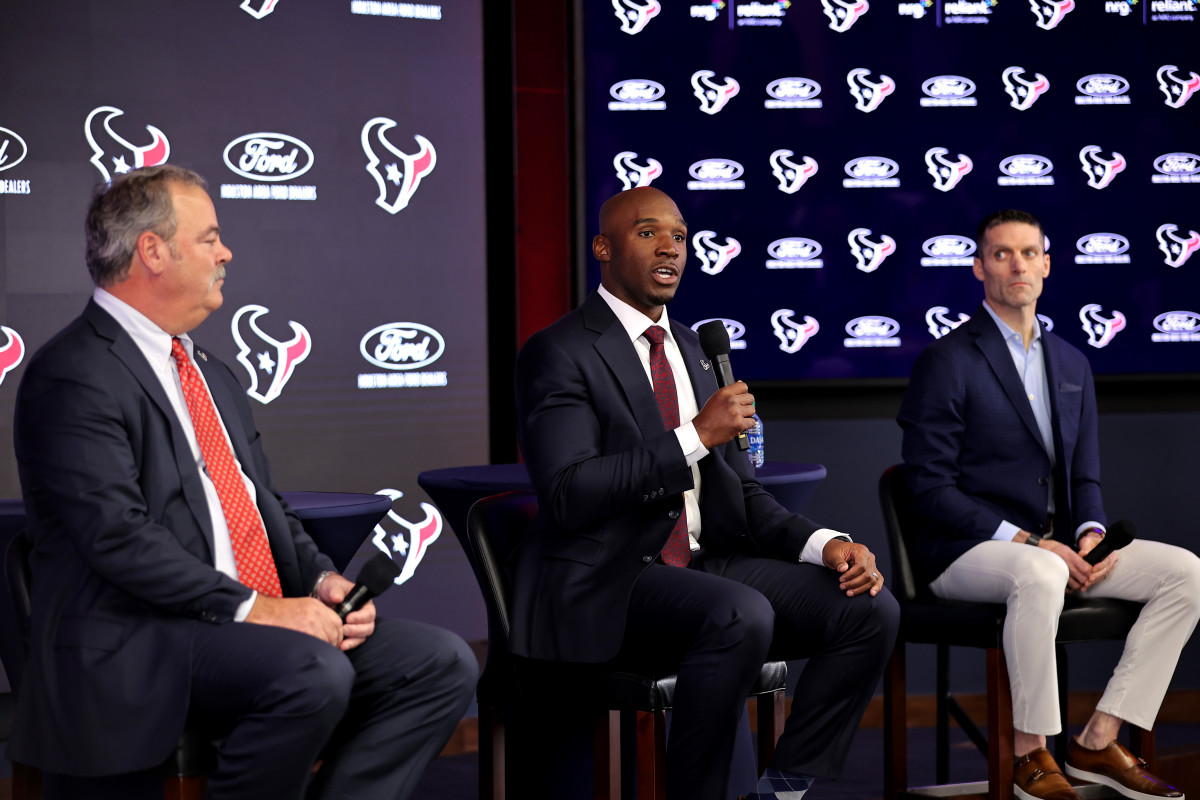As Texans Enter Free Agency, Nick Caserio Must Answer Several Key Questions
Nick Caserio silenced the doubters with one move last April.
He bet on himself with the second choice five minutes later as NFL Commissioner Roger Goodell took the podium.
The Houston Texans' faithful rejoiced. They cheered the moment as C.J. Stroud and Will Anderson Jr. took the stage and embraced their new boss.
They exploded eight months later as Stroud and Anderson paved the way on both sides of the ball behind exceptional coaching from new man DeMeco Ryans to secure the team's first division title in four years.

Yes, Caserio struck gold last offseason and changed his narrative in an instant. Now, sights turn to how he'll build off an improbable year to meet the new expectations.
Houston's 10-7 finish wasn't expected. Even local reporters and shock jocks made it seem like six or seven wins would feel like a Super Bowl moment after 11 victories in three combined years.
Stroud, the No. 2 pick, made history en route to winning Offensive Rookie of the Year. The 22-year-old is no Joe Montana or Tom Brady yet, even if he joins the two legends as the only passer to lead the NFL in yards per game (287.5) and touchdown-to-interception ratio (23-5) in the same season.
Anderson, who Houston traded multiple first-round picks to acquire at No. 3, broke J.J. Watt and Mario Williams' rookie sack record with seven quarterback hits. Watt, one of three Texans Hall of Fame members, would go on to win his first of three Defensive Player of the Year Awards a year later.
Is Anderson next? Is Houston on the rise? Will the Texans compete alongside Kansas City?
Ask Caserio as the team enters free agency. His roster construction holds the key to Houston's progress or problems entering Year 2 of a promising era.
Building a foundation starts with the draft, an area that has improved with each class under Caserio. Names like Nico Collins, Derek Stingely Jr., Jalen Pitre, Christian Harris, Tank Dell, and Juice Scruggs are expected to be building blocks in the AFC South moving forward.
Free agency fills the immediate void. Last season, Caserio upped the offensive consistency with tight end Dalton Schultz, offensive tackle George Fant and running back Devin Singletary. Defensively, the Texans' run prevention looked rebuilt overnight behind reps from linebacker Denzel Perryman and defensive tackle Sheldon Rankins.
All five players are free agents. So is leading tackler Blake Cashman (109 stops) and leading sack man Jonathan Greenard (12.5). Both have expressed interest in returning, but they also want to be properly compensated.
Houston has the cap space to offer lucrative deals to a handful of staples from last season. Does it have enough to upgrade other positions with new faces looking for paydays?
And how does it affect the draft? The Texans, who select No. 23 in April, have been linked to countless positions, including defensive tackle, receiver, and cornerback. Should Greenard re-sign, does pass-rusher move down the pecking order?
Does it move up if cornerback Steven Nelson were to re-sign while Greenard heads elsewhere? Spotrac projects the fourth-year pro to earn roughly $14-16 million annually, but others believe that number could reach over $20 million.
Schultz might be a priority signing after serving as a security blanket for Stroud. In a weaker tight end free-agent class, he's likely to command top dollar. Is Caserio willing to let his quarterback lose a weapon because he wants $13 million annually instead of 10?
What free agents could be interested in joining the Texans? What's the asking price, too? Houston has been linked to Tampa Bay Buccaneers star and Galveston native Mike Evans. He's cashing in on another 1,000-yard campaign and is looking for the big bucks.
What does 'big' mean? One source told TexansDaily.com that $25 to $28 million seems to be the going rate for the 30-year-old.
Evans would join the fold, but would anyone else?
Buckeyes Bond: Texans' Stroud Reveals Fields, Bears Take
The combine starts next week in Indianapolis. Free agency begins on March 13. That's a two-week window to finalize a strategy entering the open market on what to target, what to avoid, and what to over or underpay.
Last offseason, the New York Giants were looking to build off a postseason berth for the first time in six years. Despite spending big, New York walked away from the table a loser with a top-10 pick attached to its name.
Will that be Houston this time next February? It could.
Caserio holds the cards. It's time to see if he's bluffing or banking.
